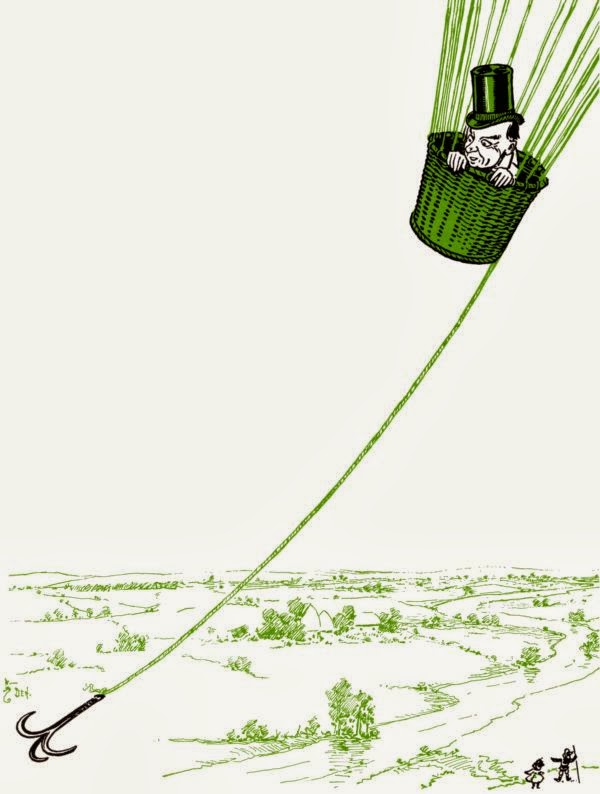In which our heroine rescues and repairs her various compatriots, the hilariously-named history of the Winged Monkeys is revealed, the Great and Terrible Oz tries to go back on his promises, and some attention is paid to a man behind a curtain.
Pssh, a comparatively minor nineteen illustrations from Mr. Denslow this time around, though they do include depictions of one of my favorite passages in all the Oz books, the story of Gayelette and Quelala, because seriously how great are those names.
The repairs to the Tin Woodman and the Scarecrow bring up some interesting questions abut their natures. If the Scarecrow has no straw in him, is he still alive? Like, can the empty sack of his head still see, or hear, or talk? Does he need to be stuffed with straw, or would something else work? (We see in a later book that hay works, but what about, like, cotton?) Which parts of his clothing/body are necessary? Could he replace his gloves with new one if those get worn out, and have them function just as well as hands? What about his shirt/torso? Could you make him a new shirt that had three arms, and have all of them work? They've repainted his face, but could they replace the whole head and still have it work? Would the old one just "shut down" or something? How much could you replace before he's not the Scarecrow anymore, and is just a scarecrow?
Similar questions abound for the Tin Woodman, and get especially complicated because he used to be human. Replacing his limbs and even torso with tin... yeah, sure, why not. But how exactly did they get the essence of the human he was into the tin head he now has? They explicitly say the tinsmith didn't transfer his brain over, so how did the tinsmith make him... still him? As Baum goes on with the books and matures as a writer, fleshing out the world of Oz more and more, these questions do actually get addressed. Sort of. Most of he probably wisely decides to ignore, despite over-thinkers like me, but the way some of it does get addressed is both confusing and terrifying. Stay tuned!
But, wait. They first encountered the Queen of the Field Mice far on the other side of the Emerald City, as they were walking from the East. Now, they're far in the West (and going the wrong way, putting them even farther away) and she is able to respond so quickly to the whistle? Was she following them this whole time, or did she just happen to be passing through?
Okay, I'm not the only one who finds the whole story of Quelala hilarious, right? I mean, first off, we've got Gayelette, the beautiful and wise princess who can't find a husband because all the men are too stupid (...WAIT A MINUTE) but then finds this young boy and basically raises him to be her husband as though that's not creepy at all. Then, of course, we've got that their names are Gayelette and Quelala, and that the whole problem is that the Winged Monkeys got water spots on Quelala's pretty pink silk and purple velvet outfit, so this good and wise sorceress condemns them to slavery. We also never find out exactly how the Wicked Witch came upon the Golden Cap. Last we knew, Quelala still had it with two commands left. Did the Witch steal it from him? Did he lose it, or what?
Also, I laugh, but I would look pretty good in some pink silk and purple velvet.
You may have noticed by now that nearly all of Denslow's illustrations in this book are colored-coded: they were tinged brown in Kansas, blue in Munchkinland, red when encountering the poppies, green in and approaching the Emerald City, and yellow in the land of the Winkies. Now that we're heading back to the Emerald City, of course, we return to green. Color-coding, especially pertaining to the various countries in Oz is taken to an almost ridiculous degree in some of the later books.
So, really, has no one in the city figure out that looking through green glasses will make everything look... green? I mean, they referred to the servant as "the pretty green girl," but did none of them notice that Dorothy was also a green girl at the time? And... why, exactly, was the Wizard doing this again? Wasn't the city pretty enough as it was?
Wow, this ended up being an especially over-analytical and nit-picky set of chapters for me. Well, I firmly believe that you can love and enjoy something and still be aware of or even critical of its quirks and flaws at the same time. In fact, some of those self-same quirks can be quite endearing in their own right.
If you would like to read along, the text can be found at Project Gutenberg here without pictures, or here with. Though the illustrated page is where I got our illustrations from, the layout is wonky and can be hard to read, so to see what the text looks like with the illustrations properly integrated, take a look at this facsimile of the original edition up at openlibrary.org. No reading ahead, though!




















No comments:
Post a Comment